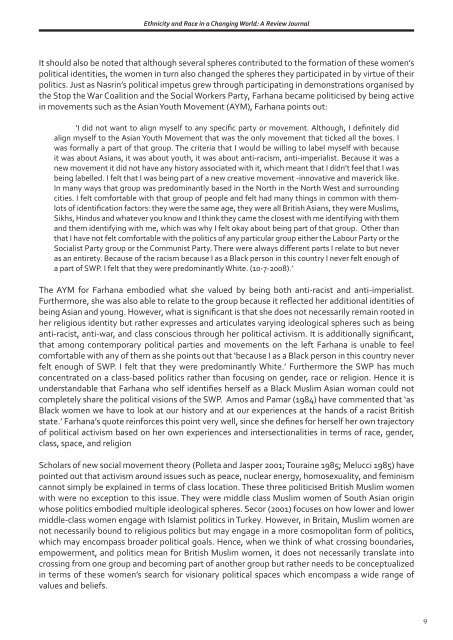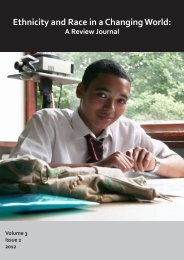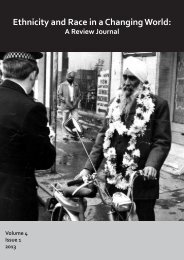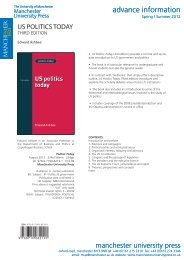Ethnicity and Race in a Changing World
Volume 2, Issue 1, 2010 - Manchester University Press
Volume 2, Issue 1, 2010 - Manchester University Press
- No tags were found...
You also want an ePaper? Increase the reach of your titles
YUMPU automatically turns print PDFs into web optimized ePapers that Google loves.
<strong>Ethnicity</strong> <strong>and</strong> <strong>Race</strong> <strong>in</strong> a Chang<strong>in</strong>g <strong>World</strong>: A Review JournalIt should also be noted that although several spheres contributed to the formation of these women’spolitical identities, the women <strong>in</strong> turn also changed the spheres they participated <strong>in</strong> by virtue of theirpolitics. Just as Nasr<strong>in</strong>’s political impetus grew through participat<strong>in</strong>g <strong>in</strong> demonstrations organised bythe Stop the War Coalition <strong>and</strong> the Social Workers Party, Farhana became politicised by be<strong>in</strong>g active<strong>in</strong> movements such as the Asian Youth Movement (AYM), Farhana po<strong>in</strong>ts out:‘I did not want to align myself to any specific party or movement. Although, I def<strong>in</strong>itely didalign myself to the Asian Youth Movement that was the only movement that ticked all the boxes. Iwas formally a part of that group. The criteria that I would be will<strong>in</strong>g to label myself with becauseit was about Asians, it was about youth, it was about anti-racism, anti-imperialist. Because it was anew movement it did not have any history associated with it, which meant that I didn’t feel that I wasbe<strong>in</strong>g labelled. I felt that I was be<strong>in</strong>g part of a new creative movement -<strong>in</strong>novative <strong>and</strong> maverick like.In many ways that group was predom<strong>in</strong>antly based <strong>in</strong> the North <strong>in</strong> the North West <strong>and</strong> surround<strong>in</strong>gcities. I felt comfortable with that group of people <strong>and</strong> felt had many th<strong>in</strong>gs <strong>in</strong> common with themlotsof identification factors: they were the same age, they were all British Asians, they were Muslims,Sikhs, H<strong>in</strong>dus <strong>and</strong> whatever you know <strong>and</strong> I th<strong>in</strong>k they came the closest with me identify<strong>in</strong>g with them<strong>and</strong> them identify<strong>in</strong>g with me, which was why I felt okay about be<strong>in</strong>g part of that group. Other thanthat I have not felt comfortable with the politics of any particular group either the Labour Party or theSocialist Party group or the Communist Party. There were always different parts I relate to but neveras an entirety. Because of the racism because I as a Black person <strong>in</strong> this country I never felt enough ofa part of SWP. I felt that they were predom<strong>in</strong>antly White. (10-7-2008).’The AYM for Farhana embodied what she valued by be<strong>in</strong>g both anti-racist <strong>and</strong> anti-imperialist.Furthermore, she was also able to relate to the group because it reflected her additional identities ofbe<strong>in</strong>g Asian <strong>and</strong> young. However, what is significant is that she does not necessarily rema<strong>in</strong> rooted <strong>in</strong>her religious identity but rather expresses <strong>and</strong> articulates vary<strong>in</strong>g ideological spheres such as be<strong>in</strong>ganti-racist, anti-war, <strong>and</strong> class conscious through her political activism. It is additionally significant,that among contemporary political parties <strong>and</strong> movements on the left Farhana is unable to feelcomfortable with any of them as she po<strong>in</strong>ts out that ‘because I as a Black person <strong>in</strong> this country neverfelt enough of SWP. I felt that they were predom<strong>in</strong>antly White.’ Furthermore the SWP has muchconcentrated on a class-based politics rather than focus<strong>in</strong>g on gender, race or religion. Hence it isunderst<strong>and</strong>able that Farhana who self identifies herself as a Black Muslim Asian woman could notcompletely share the political visions of the SWP. Amos <strong>and</strong> Pamar (1984) have commented that ‘asBlack women we have to look at our history <strong>and</strong> at our experiences at the h<strong>and</strong>s of a racist Britishstate.’ Farhana’s quote re<strong>in</strong>forces this po<strong>in</strong>t very well, s<strong>in</strong>ce she def<strong>in</strong>es for herself her own trajectoryof political activism based on her own experiences <strong>and</strong> <strong>in</strong>tersectionalities <strong>in</strong> terms of race, gender,class, space, <strong>and</strong> religionScholars of new social movement theory (Polleta <strong>and</strong> Jasper 2001; Toura<strong>in</strong>e 1985; Melucci 1985) havepo<strong>in</strong>ted out that activism around issues such as peace, nuclear energy, homosexuality, <strong>and</strong> fem<strong>in</strong>ismcannot simply be expla<strong>in</strong>ed <strong>in</strong> terms of class location. These three politicised British Muslim womenwith were no exception to this issue. They were middle class Muslim women of South Asian orig<strong>in</strong>whose politics embodied multiple ideological spheres. Secor (2001) focuses on how lower <strong>and</strong> lowermiddle-class women engage with Islamist politics <strong>in</strong> Turkey. However, <strong>in</strong> Brita<strong>in</strong>, Muslim women arenot necessarily bound to religious politics but may engage <strong>in</strong> a more cosmopolitan form of politics,which may encompass broader political goals. Hence, when we th<strong>in</strong>k of what cross<strong>in</strong>g boundaries,empowerment, <strong>and</strong> politics mean for British Muslim women, it does not necessarily translate <strong>in</strong>tocross<strong>in</strong>g from one group <strong>and</strong> becom<strong>in</strong>g part of another group but rather needs to be conceptualized<strong>in</strong> terms of these women’s search for visionary political spaces which encompass a wide range ofvalues <strong>and</strong> beliefs.9






